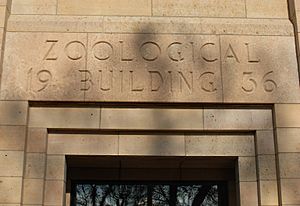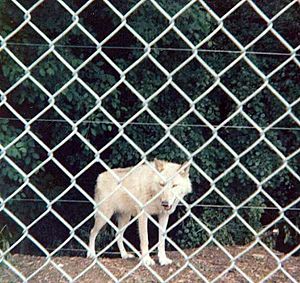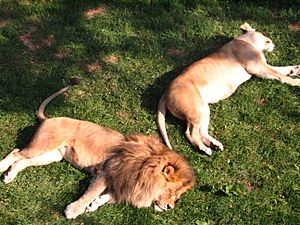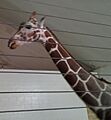Como Zoo facts for kids

1936 Como Zoo Zoological Building
|
|
| Date opened | 1897 |
|---|---|
| Location | Saint Paul, Minnesota, United States |
| Land area | 17 acres (6.9 ha) |
| Coordinates | 44°58′56″N 93°9′14″W / 44.98222°N 93.15389°W |
| No. of animals | 1,700 |
| No. of species | 66 |
| Annual visitors | 1.9 million |
| Memberships | AZA |
Como Zoo is a super fun place to visit in Saint Paul, Minnesota. It was the first zoo ever built in Minnesota! It started way back in 1897. The zoo is part of Como Park. It's a special place where you can see many amazing animals. Como Zoo is also a member of the Association of Zoos and Aquariums (AZA). This means it meets high standards for animal care.
Contents
History of Como Zoo: A Journey Through Time
How Como Zoo Started
Como Zoo began in 1897. The city of Saint Paul received a gift of three deer. They needed a place for them to live. So, a simple fenced area was made for the deer. This was the very first step in creating the zoo!
Growing Animal Collection
In 1902, the zoo got more animals. These included animals native to Minnesota, like elk and moose. They also got foxes and two cebus cattle. People even donated pets, such as a parrot and a monkey.
In 1915, the zoo received two bison. These were a gift from Thomas Frankson. He later became the Lieutenant Governor of Minnesota. Also in 1915, the Marjorie McNeely Conservatory was built. This beautiful building helped keep animals warm in winter.
A black bear named Peggy joined the zoo in 1926. Her cage was made from old iron arches.
New Buildings and Exotic Animals
The 1930s brought exciting changes. Monkey Island was built in 1932. Then came the bear grottos. The main Zoological Building opened in 1936. Many exotic animals arrived from the Longfellow Gardens zoo. That zoo closed in 1934.
In the 1940s, the zoo kept growing. They added paved parking lots. A Kiddie Zoo was created for younger visitors. There was also a raccoon pit, which later became Prairie Dog Hill.
Saving the Zoo in the 1950s
The 1950s saw more changes. Rabbitville was added. It later grew into a Children's Farm Zoo. In 1955, city leaders thought about closing the zoo. They felt there wasn't enough money to support it. But citizens formed a group to save the zoo!
Thanks to their efforts, many repairs were made. New animals arrived, like ostriches, jaguars, and seals. In 1957, some endangered animals joined. These included Siberian tigers, gorillas, and orangutans.
In 1958, Toby the Galápagos tortoise came to live at the zoo. Kids could even ride on Toby's back! Also in 1958, the first Siberian tigers born in captivity happened at Como Zoo. In 1959, Casey the gorilla arrived. The Como Mobile Zoo also started visiting local schools.
Challenges and Comebacks in the 1960s and 1970s
The 1960s were tough for Como Zoo. In 1966, a report suggested Como Zoo couldn't become a major zoo. Plans for the Minnesota Zoo began. Many thought Como Zoo would close. But in 1969, citizens rallied again. They raised money to save the zoo. A new primate house was built. Two new lowland gorillas, Don and Donna, arrived.
In 1974, Toby the tortoise moved to the Honolulu Zoo. He still lives there today! In 1976, a new plan was made to improve the zoo. The State Legislature gave $8.5 million for this big project.
Exciting New Exhibits in the 1980s
The 1980s brought many new buildings. The Large Cats exhibit opened in 1980. In 1982, the new Aquatic Animal building opened. Other additions included a new polar bear exhibit. There was also a new amphitheater for the Sparky the Sea Lion Show. Monkey Island became Seal Island.
Casey II, the grandson of the first Casey gorilla, arrived. He came from the Gladys Porter Zoo in Brownsville, Texas. In 1985, Como Zoo's Primate House was rebuilt. It housed gorillas, orangutans, lemurs, and monkeys.
In 1986, the new Land Bird and Water Fowl exhibit was finished. It had a large outdoor pool. In 1988, the African Hoof Stock exhibit was completed. This was the last part of the 1970s master plan. It had giraffes, zebras, and ostriches.
Changes in the 1990s
In 1994, Don the gorilla passed away. Later, Casey II the gorilla had an adventure! He jumped out of his exhibit. He took a short walk in the park. Then he jumped right back into his home! This led to plans for a new gorilla exhibit. It was designed with straight walls to keep gorillas safely inside. Casey II later moved to the Audubon Zoo in New Orleans.
Modern Era: 2000s and 2010s
In 2008, the zoo's giraffes had a baby. The baby had trouble walking. It was moved to the University of Minnesota for special care. Luckily, the baby giraffe got better! It returned to the zoo and is now on exhibit.
The building of the new Polar Bear Odyssey began. It replaced the old bear grottos. The new exhibit is seven times bigger than the original!
The Polar Bear Odyssey opened in 2010. Gorilla Forest opened in 2013. It is home to Schroeder, a 500-pound silverback male gorilla. He lives with three female companions. Two daughters were born to the females. There is also a group of three other male gorillas.
Past Exhibits at Como Zoo
Over the years, some exhibits have been replaced. These include Prairie Dog Hill, The Raccoon Pit, Monkey Island, Rabbitville, Children's Farm Zoo, Kiddie Zoo, Deer Pasture, Seal Island, and the original 1936 Zoological Building.
Explore the Exhibits at Como Zoo
Bird Yard Exhibit
The Bird Yard is one of the first things you see. It has a large pool and a waterfall. There's even a mill house with a water wheel. Large rocks separate the birds from two big Galápagos tortoises. You can see Chilean flamingos, mallard ducks, and red-breasted geese here.
Primate House
The Primate House was rebuilt in 1985. It's home to many amazing primates. You can find blue-eyed lemurs, patas monkeys, and emperor tamarins. Look for golden-headed lion tamarins, spider monkeys, and western lowland gorillas. Also living here are Sumatran orangutans and Hoffmann's two-toed sloths.
Large Cats Exhibit
The Large Cats exhibit opened in 1980. It gave the big cats much more space. Here you can see powerful Siberian tigers, majestic lions, and stealthy snow leopards. Don't miss the cougars too!
Aquatic Building
The Aquatic Building opened in 1982. It's filled with fascinating water animals. You can watch African penguins swim. See lined seahorses, mudpuppies, and tufted puffins. There are also archerfish and colorful African cichlids.
Como Harbor
Como Harbor is a newer exhibit, opened in 2021. It's home to amazing marine mammals. You can see playful harbor seals, graceful gray seals, and clever California sea lions.
African Hoof Stock
The African Hoof Stock exhibit was finished in the mid-1980s. It brings a piece of Africa to Minnesota. Here you can observe Grant's zebras and tall reticulated giraffes. Look for Nyala, an African spurred tortoise, and ostriches. A beautiful Crowned crane also lives here.
Old Hoof Stock
The Old Hoof Stock building is one of the zoo's oldest exhibits. It houses animals adapted to different climates. You can see plains bison, Dall sheep, and clever Arctic foxes. Reindeer also call this exhibit home.
Tropical Encounters Exhibit
The Tropical Encounters Exhibit opened in 2005. It's like stepping into a rainforest! You'll find Arrau turtles and colorful birds like bay-headed tanagers. Look for Emerald tree boas and leafcutter ants. There are also unique fish like black pacu and peacock bass. Keep an eye out for green anacondas!
Wolf Woods
Wolf Woods is a special forested area. It's home to two beautiful gray wolves. You can watch them explore their natural-looking habitat.
Polar Bear Odyssey
The Polar Bear Odyssey opened in 2010. It's a huge home for the zoo's polar bears. This exhibit is four times bigger than the old one! You can watch the bears swim from an inside viewing area. Interactive computers teach you about the Arctic and how the world is changing.
Images for kids
-
Geoffroy's spider monkey (Ateles geoffroyi) grooming.
-
Como Zoo is connected to the Marjorie McNeely Conservatory.












